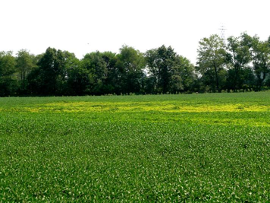ILSOYADVISOR POST
SCN in Soybeans: Do I have an issue?
As I drove around Southern IL this summer, I noticed a lot of fields that have areas in them that were showing the symptomology of Soybean Cyst Nematode (SCN). Often these spots are stunted, yellow and just generally not in good health. Now, there are a lot of reasons for soybeans to show this symptomology, and very likely not every one of these spots were SCN, but SCN counts have been on the rise over the last few years and now is a great time to be testing for the pest.

SCN, like all nematode species, is an unsegmented roundworm. Stages in the life cycle include egg, juveniles (larvae), and adult. The infective stage of the nematode is a microscopic worm-like second stage juvenile which hatches from an egg and moves a short distance through the soil until it encounters a soybean root. The juvenile enters the root, begins to feed, and eventually grows into a lemon-shaped adult female which may contain 200-500 eggs. At this stage the nematode is loosely attached to the root by the head and neck, with the visible swollen portion of the body protruding from the root surface. When the female dies, the cuticle turns brown and becomes a tough, protective package for these eggs. This stage, called a cyst, is very resistant to decay and can remain in the soil for many years with viable eggs ready to hatch.
The period right after a susceptible crop is when the cysts should be at the highest levels and is a good time to pull the samples, from now until right after harvest. A soil probe and plastic bucket used for soil sampling works very well for SCN sampling as well. Walk a “zig-zag” pattern across the field collecting 20-25 cores, with a typical one-inch diameter, mixing the cores very well before placing into a labeled bag. Have each sample represent between 20-25 acres. If you are doing “problem area” sampling, it is recommended to pull a sample from a “good spot” in the same field, so you have a reference sample as well. For more information on collecting nematode soil samples and submitting materials visit the U of I Plant Clinic.
If no infestation is found, use good management practices, and rotate a combination of resistant or susceptible varieties in the field.
If SCN is found:
• Rotate to non-host crops such as corn or wheat.
• Consider using a nematode protectant seed treatment.
- Nematicide seed treatments are intended to supplement current SCN management strategies, not replace them. Seed treatments should therefore be used in coordination with SCN-resistant varieties and rotation to non-host crops.
• Control alternate weed hosts such as henbit, purple deadnettle, field pennycress, shepherd’s purse, small- flowered bittercress and common chickweed.
• Rotate resistant varieties.
- A large percentage of soybean varieties on the market today use PI 88788 as the source of resistance. There are a few varieties on the market that use Peking as the source of resistance and would be a good rotational source.
Based on the actual counts, the lab will also give some guidelines for management.
Don’t miss the opportunity this fall to get the answers to why “that one spot in the field” hasn’t looked good all year. Testing for SCN is simple and inexpensive, and procrastinating will only mean you miss the prime time to sample.





Comments
Add new comment